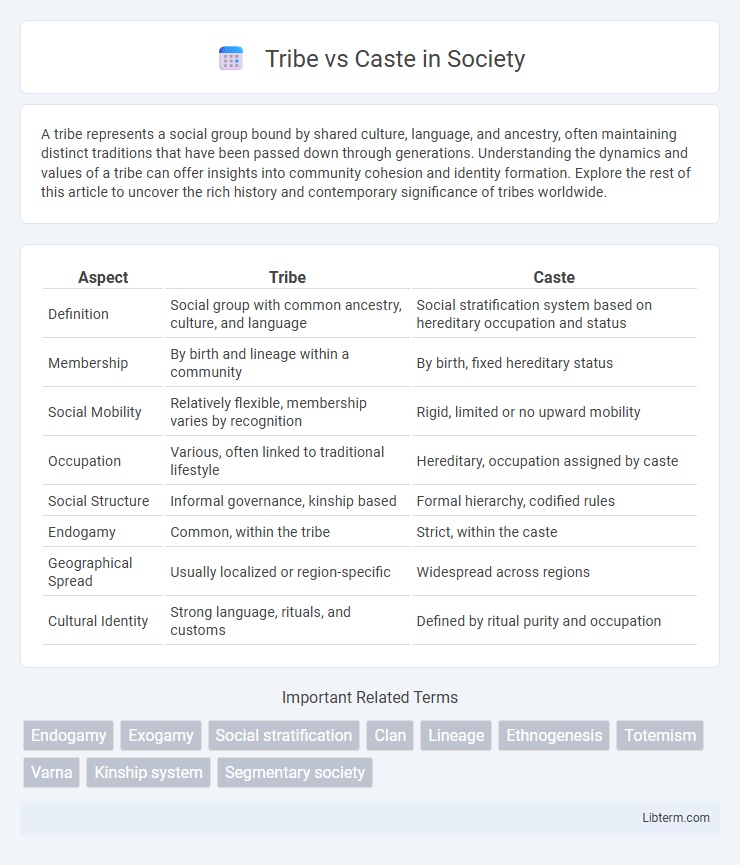A tribe represents a social group bound by shared culture, language, and ancestry, often maintaining distinct traditions that have been passed down through generations. Understanding the dynamics and values of a tribe can offer insights into community cohesion and identity formation. Explore the rest of this article to uncover the rich history and contemporary significance of tribes worldwide.
Table of Comparison
| Aspect | Tribe | Caste |
|---|---|---|
| Definition | Social group with common ancestry, culture, and language | Social stratification system based on hereditary occupation and status |
| Membership | By birth and lineage within a community | By birth, fixed hereditary status |
| Social Mobility | Relatively flexible, membership varies by recognition | Rigid, limited or no upward mobility |
| Occupation | Various, often linked to traditional lifestyle | Hereditary, occupation assigned by caste |
| Social Structure | Informal governance, kinship based | Formal hierarchy, codified rules |
| Endogamy | Common, within the tribe | Strict, within the caste |
| Geographical Spread | Usually localized or region-specific | Widespread across regions |
| Cultural Identity | Strong language, rituals, and customs | Defined by ritual purity and occupation |
Definition of Tribe and Caste
Tribes are social groups traditionally characterized by shared ancestry, language, culture, and territory, often functioning with a degree of political autonomy and kinship-based organization. Castes are hereditary social classes defined by occupation, endogamy, and ritual status, primarily found within the hierarchical structure of Indian society. Unlike tribes, caste membership is fixed by birth and enforces strict social boundaries and duties within a stratified system.
Historical Origins and Evolution
Tribes and castes originate from distinct historical frameworks: tribes emerge from kinship-based societies with shared ancestry and cultural practices, while castes develop from rigid social stratifications often linked to occupational roles and religious codification in ancient civilizations like India. Tribal systems typically evolved in decentralized social structures with fluid social roles, whereas caste systems became institutionalized with strict hereditary boundaries and social hierarchy enforced through religious doctrines such as the Varna system. Over time, tribes maintained relative autonomy and cultural diversity, while castes solidified into complex societal networks influencing social mobility, marriage, and economic opportunities.
Social Structure and Organization
Tribes are organized through kinship ties and social clans, with leadership often based on consensus or hereditary roles, emphasizing communal decision-making and shared resources. Castes represent rigid social strata characterized by hereditary occupational roles and strict social boundaries, resulting in limited mobility and predefined social duties. Tribal social structures tend to emphasize egalitarian relations within groups, while caste systems enforce hierarchical distinctions and social stratification within the broader society.
Cultural Practices and Beliefs
Tribes maintain distinct cultural practices centered on animism, oral traditions, and kinship-based community structures, emphasizing collective rituals and nature worship. Castes operate within stratified social hierarchies governed by hereditary roles and occupational duties, often linked to Hindu religious doctrines such as Dharma and Karma. Tribal beliefs foster a holistic relationship with the environment, while caste-based customs reinforce social order through ritual purity and prescribed ceremonies.
Geographical Distribution
Tribes primarily inhabit remote and forested regions across countries such as India, Africa, and parts of Southeast Asia, often maintaining distinct cultural practices tied to their specific environments. Castes, predominantly found in South Asia, especially India and Nepal, are spread across both rural and urban areas, structured by hereditary social stratification rather than geographic isolation. The geographical distribution of tribes correlates with ecological niches, whereas castes exhibit a more uniform presence integrated within broader societal frameworks.
Economic Roles and Livelihoods
Tribes often engage in subsistence economies based on hunting, gathering, or pastoralism, with communal ownership of resources shaping their economic roles. Castes, particularly in South Asia, traditionally correspond to hereditary occupations, creating a rigid division of labor within agriculture, craftsmanship, and trade. Economic mobility tends to be limited in caste systems due to social restrictions, whereas tribal economies are generally more flexible but less integrated into mainstream markets.
Legal Status and Government Policies
Tribes in India are recognized as Scheduled Tribes under the Constitution, granting them specific legal protections and benefits such as reservations in education, employment, and political representation to promote socio-economic development. Castes categorized as Scheduled Castes receive similar affirmative action measures aimed at reducing historical social discrimination and economic disparities. Government policies distinctly address tribes through the Fifth and Sixth Schedules, enabling autonomous governance in certain areas, while caste-based policies focus on social upliftment through welfare schemes and reservation quotas.
Social Mobility and Integration
Tribes often exhibit fluid social structures that allow greater social mobility through mechanisms like merit, marriage, and leadership roles, contrasting with rigid caste systems that enforce hereditary status and limit upward movement. Tribal societies integrate members through kinship ties and shared cultural practices, fostering inclusivity and adaptive social cohesion. Caste systems, by enforcing strict social stratification and endogamy, inhibit integration and maintain hierarchical divisions, impacting social dynamics and mobility.
Discrimination and Social Challenges
Tribes and castes both face discrimination, but tribal communities often experience marginalization due to their indigenous status and loss of traditional land, while caste-based discrimination is deeply rooted in hierarchical social practices and untouchability. Social challenges for tribes include limited access to education, healthcare, and political representation, whereas caste groups face exclusion in social interactions, occupational restrictions, and systemic prejudice. Legal frameworks like the Scheduled Tribes and Scheduled Castes protections aim to reduce discrimination, but social stigma and economic disparities persist in both groups.
Contemporary Relevance and Future Trends
Tribes maintain distinct cultural identities and social structures that emphasize community cohesion and indigenous rights, contrasting with the rigid, hierarchical nature of castes often associated with traditional social stratification. Contemporary relevance is evident in policies promoting tribal autonomy and affirmative action, which address historical marginalization and socio-economic disparities. Future trends indicate increased integration of tribal governance with digital technologies and sustainable development, while caste-based inequalities face gradual erosion due to urbanization and legal reforms.
Tribe Infographic

 libterm.com
libterm.com